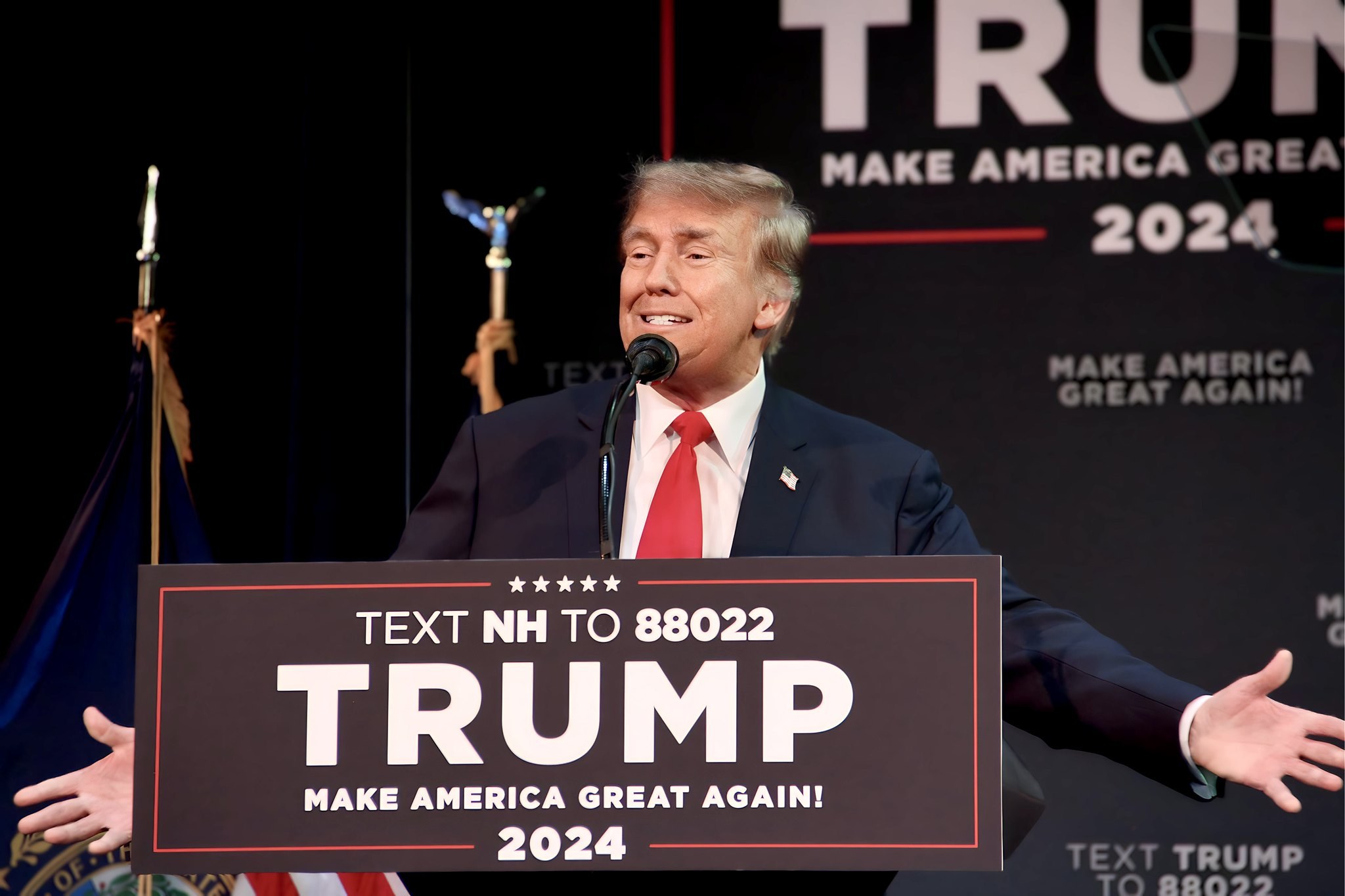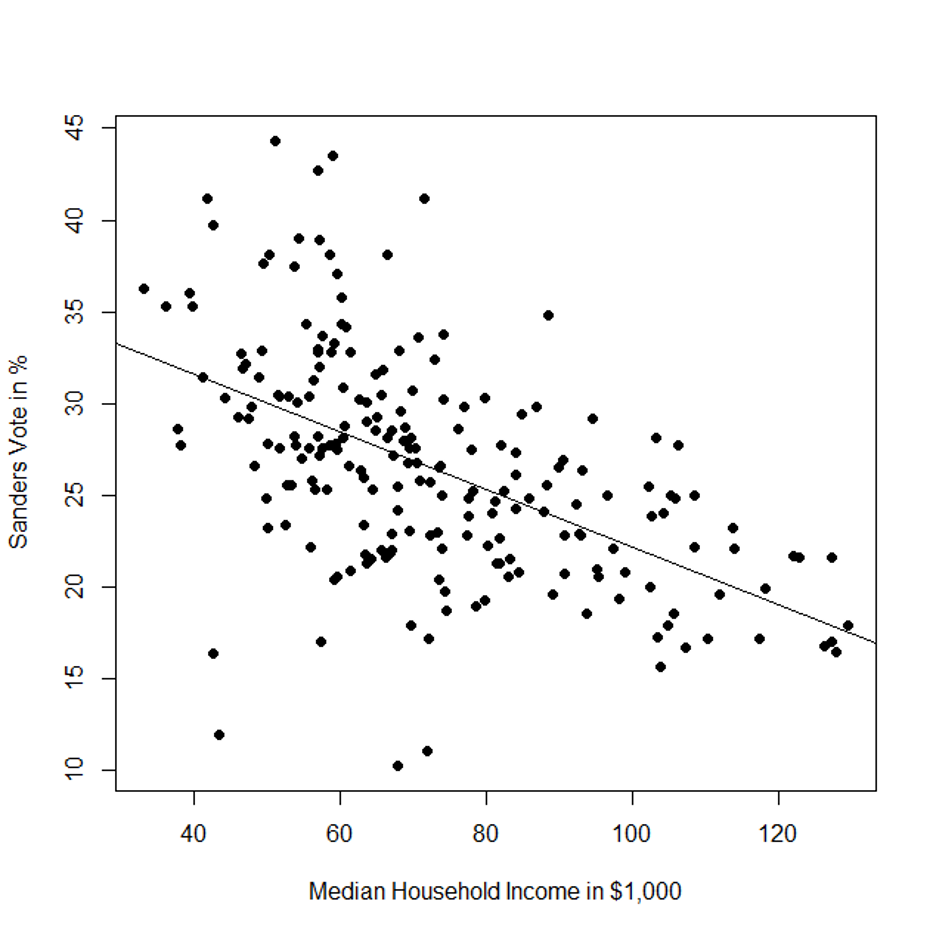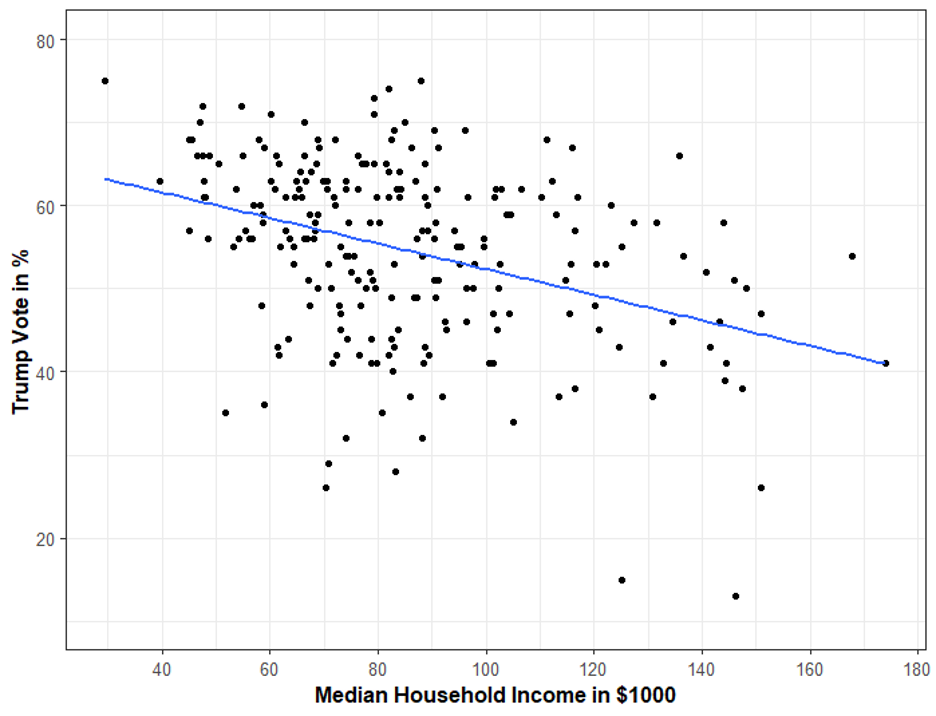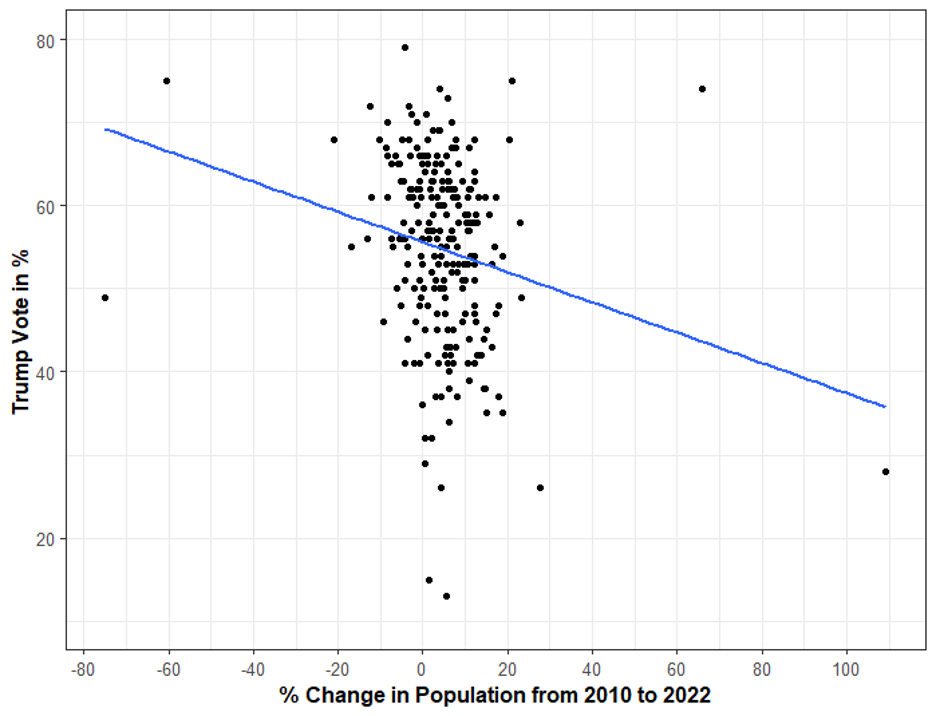Yves right here. Tom Ferguson, with Jie Chen, Paul Jorgensen, and now Matthias Lalisse, has constructed and maintained huge election databases for many years and carry out in-depth analyses on the outcomes. For example, Ferguson, Chen, and Jorgensen analyzed why Ted Kennedy’s seat went to Republican Scott Brown, depriving Obama of a filibuster-proof Senate majority. The crew decided through a granular evaluation that the proportion of Republican votes correlated strongly with the variety of foreclosures in that district.
The info-crunchers provide you with an identical conclusion for the Trump win in New Hampshire. The vote for Trump correlated negatively with native family incomes. However that’s not all the story….
By Thomas Ferguson, Analysis Director, Institute for New Financial Pondering and Professor Emeritus, College of Massachusetts, Boston; Jie Chen, College Statistician, College of Massachusetts; Paul Jorgensen, Affiliate Professor and Director of Environmental Research, College of Texas Rio Grande Valley; and Matthias Lalisse, Division of Linguistics and Cognitive Science, Johns Hopkins College. Initially revealed at the Institute for New Financial Pondering web site

4 years in the past, the important thing takeaway from the New Hampshire main was apparent. On the Democratic facet, the left populist Bernie Sanders stunned the world by popping out on high, along with his vote declining nearly in a straight line as city incomes vaulted upward. Determine 1, reproduced right here from our earlier essay, mentioned all of it:

Determine 1: Decrease Revenue Cities in New Hampshire Voted Closely for Sanders; Richer Cities Did the Reverse Supply: Ferguson, Jorgensen and Chen, 2020
A extra vivid instance of a split-level political get together may hardly be imagined.
Now, 4 years later, it’s the Republican main that highlights a dramatic financial bifurcation in a serious political get together. Donald Trump’s vote in New Hampshire is sort of a mirror picture of the 2020 Democratic end result: As Determine 2 exhibits, but once more, as city incomes elevated, the vote for the previous president plunged.

Determine 2: Trump’s Share of the Vote Fell as City Incomes Rose
The divide is definitely extra attention-grabbing than the determine suggests. A more in-depth look signifies that gradual development over an extended time period compounds the direct affect of earnings. Teasing that conclusion out of the out there knowledge takes some effort, although.
Election returns from the Granite State’s charmingly venerable (to place it politely) voting models are sometimes reported by “cities.” These come in additional sizes and styles than even many hardened spectators of American elections can simply think about. All of the rabbit warrens flip the state’s electoral map right into a loopy quilt of jurisdictions, archaic names, and imperfectly correlated census areas. In consequence, well timed and dependable contextual knowledge for a lot of voting models is typically exasperatingly troublesome to find. For a couple of small facilities, necessary measures are merely unavailable, even from state web sites that generally appear nearly to flaunt their languidly paced updates.[1]
To approximate election unit development charges over time, we turned to a stratagem that we now have utilized in earlier research of Trump and American elections: analyzing proportional modifications in inhabitants development between 2010 and 2022 – a statistic that’s sometimes out there even for hamlets.[2]
Many New Hampshire cities present little or no development over that stretch, however there are main outliers, too, so the graph of long-term change on the town populations is a bit much less stark.[3] However the affiliation of upper Trump voting percentages with slower development is evident and simply verified. Trump beat Haley in over 80% of cities experiencing unfavorable development. In contrast, he beat Haley in simply over 60% of cities experiencing inhabitants development of over 10%.

Determine 3: The Trump Vote Additionally Ran Increased in Slower Rising Cities; Sooner Rising Areas Tilted Extra Closely Towards Him
These plots thicken – actually – if you inquire whether or not the 2 variables maybe affect one another – if, for instance, earnings’s impact on the Trump vote won’t be fixed however differ by city long-term development charges. Results of this type defy straightforward graphical illustration, and so we dispense with any right here. However they’re readily assessed statistically.
Once more, the reply is evident: The mixture of the 2 results – low incomes and low development – does certainly add as much as greater than the sum of the components. As statisticians say, they work together with one another. Trump tended to do finest in slower-growing, low-income cities. His vote fell off in faster-growing, high-income cities. Collectively the 2 variables and their interplay can clarify a couple of fifth of the full outcome. In elections that may be a substantial discovering.[4]
We draw a number of conclusions from these outcomes, although we start with the usual cautions in regards to the risks of the ecological fallacy: mixture research like our’s shouldn’t be used to make generalizations about how people and subgroups voted. For that, you want knowledge on people. For instance, voter selections amongst specific ethnicities or earnings teams might properly differ relying on whether or not they’re scattered throughout many districts or concentrated in only a few.[5]
However even with that warning, our outcomes counsel some necessary explanation why the remainder of the Republican area fared so poorly in opposition to Trump. The monetary profile of the Trump marketing campaign has at all times stood out as a barbell – at one finish a mass of small donations; on the different, a weighty golden throne of huge cash.[6] It was so in 2016 and 2020; and sufficient proof is in already to know that 2024 is repeating that sample, even earlier than the various Republican holdouts who now seem like reconciling themselves to his nomination lastly resolve to leap in.[7] In contrast the remainder of the Republican area – even the millionaires – had no life like prospect of successful with out huge inflows of funds. They needed to chase cash and did, with DeSantis and Haley cashing in most closely.
The give attention to attracting main donors had predictable results on their marketing campaign appeals. The candidates have been glad to affix Trump in proclaiming world warming to be both a hoax or vastly exaggerated and insisting that “drill, child, drill’ needs to be America’s vitality coverage of selection. Strains like these herald loads of cash from fully predictable sources. Trump’s disdain for regulation and authorities crimson tape are two extra profitable themes that rock no boats inside the GOP. And all of them regarded kindly on some form of “wall” on the border. On this sense, the Republican Celebration nonetheless shares some frequent core propositions.
However in ways in which matter most, it now not does. The rift between Trump and the Republican Institution on fundamental financial coverage has at all times run deep, however now it has widened right into a Grand Canyon. The New Hampshire outcomes testify how little most of the additionally ran’s favourite financial themes – the perils of the deficit, chopping Social Safety, or crypto – moved Trump’s core constituency. Giant numbers of Trump voters depend on Social Safety to get by and easily chopping authorities expenditure can hardly rank as their first precedence. Trump bluntly suggested Congressional Republicans to go away Social Safety alone and his marketing campaign places the well-known MAGA – Making American Nice Once more – proper up entrance. He talks continuously of rebuilding the commercial base, the virtues of Made in America, and – above all – the pressing want for greater tariffs and extra aggressive export insurance policies.
Election analysts underestimate the resonance of those appeals in the present day at their peril, partially as a result of typical ballot questions on commerce are so poor. The New Hampshire outcomes are according to cautious research of what really moved particular person voters from the earliest days of Trump’s candidacy, when his emphasis on tariffs and financial nationalism stood out in the remainder of the Republican area. Whereas the very newest financial numbers look higher and the state for certain benefited from packages that the Biden administration has now wound down, the general financial information for many New Hampshire residents has been grim. Because the New Hampshire Fiscal Institute summarized issues in September 2023, “Newest Census Bureau Knowledge Present Median Family Revenue Fell Behind Inflation, Tax Credit score Expirations Elevated Poverty.”
Many critics of Trump pay little consideration to the main points of his precise financial report earlier than Covid hit. They thus miss how his 2024 appeals are drawing power from cultivated recollections of how the financial system fared on his watch.
It’s completely true that by historic requirements, the time path of financial development beneath Trump was not outstanding, even earlier than 2020…. his total financial insurance policies powerfully bolstered the stark divides of America’s twin financial system. However as 2018 became 2019 and inflation did not take off regardless of story after story within the enterprise press in regards to the difficulties companies have been having discovering employees…Wages have been hardly rising…[but] within the quick run incomes have been growing as a result of individuals may ultimately get extra hours of comparatively low-paid work as employers grew to become extra keen to take a look at individuals that they had beforehand written off. Individuals have been reentering the labor power and even long-term charges of unemployment have been falling. It was additionally simpler to search out second and third precarious gig jobs if individuals needed them … charges of unemployment for Blacks, Hispanics, and different teams fell to traditionally low ranges earlier than the pandemic (Ferguson, Jorgensen, and Chen, 2021).
Voters left behind by many years of globalized finance and manufacturing don’t miss his message or that his Republican opponents had nothing to supply them.
Apart from rhetoric in regards to the “Different.” Right here a have a look at the nice arc of the marketing campaign is instructive. DeSantis particularly fairly intentionally tried to steal basically all of Trump’s cultural garments. He posed as a simpler Trump, somebody able to getting issues finished whereas hitting laborious on nearly each hot-button cultural challenge: He picked a quarrel with Disney and different favourite targets of the correct, whereas filling his marketing campaign with infinite canine whistles drawn from laborious proper racial and gender memes, together with jeremiads about abortion, Covid vaccination, college libraries, and labels on rest room doorways.
However if you’d like that kind of factor, it’s in all probability unattainable to high Trump himself, who remains to be carrying on about “immigrants poisoning the blood of our nation,” at the same time as Democrats fear in regards to the erosion of assist amongst Hispanic voters.
The 2024 race for the presidency is certainly trying peculiar. The 2020 New Hampshire main illustrated how tensions between huge cash and the mass base of the Democrats have been bringing the Celebration nearly to a degree of collapse. However the Biden administration didn’t make the error Hillary Clinton’s marketing campaign did in 2016: it didn’t ostracize the Sanders wing of the get together. As an alternative, it introduced its leaders into many, if removed from all its councils, and accepted a few of their coverage proposals, particularly when substantial numbers of huge donors additionally favored them, similar to its measures to abate local weather change.
This 12 months’s New Hampshire main testifies to the disintegration of the Republican Celebration: conventional “nation membership” Republicanism is lifeless as a mass power, killed off by its efforts to make use of canine whistles as an alternative to financial insurance policies that supply one thing actual to the remainder of the inhabitants within the face of a challenger who owns each canine whistle in sight but in addition has a forthright different financial coverage.[8]
How all this performs out in November is anybody’s guess, even whether it is true that the entire world actually is watching. American politics proper now’s like late winter ice on a New Hampshire barn roof: It may slide off as simply on the left as on the correct or slowly soften down evenly for a very long time. The one factor we all know for certain is that we have no idea. The abortion challenge nonetheless cuts closely in favor of the Democrats. However we don’t share the widespread confidence that “Crew Transitory” has received the argument over inflation. In a globally warming, multipolar world, shocks of every kind simply maintain coming, as the newest developments within the Crimson Sea illustrate. And overseas coverage disasters on the size of 1980, or an even bigger border disaster, may restructure American politics in a flash.
Notes
Because of Gail Chaddock, James Kurth, and Pia Malaney for very useful feedback.
[1] Our election knowledge come from the New York Instances compilation. This was archived some days after the election, so it’s practically, however not fairly, full. However higher knowledge just isn’t out there in public. We checked the few different inventories we discovered, however they have been inferior. We took city earnings knowledge from the New Hampshire Division of Environmental Providers. This presents U.S. Census knowledge, however it compiles a number of choices for some “cities.” We in contrast its varied entries and tried to make use of the figures that the majority intently matched with the unit reporting the returns. In any case, it doesn’t matter; we checked whether or not totally different selections mattered. They differ trivially. One omission is price flagging: There isn’t any entry for median family earnings for Dixville Notch. We needed to omit it. Most likely it’s an outlier to the generalizations on this paper since its votes went to Haley – all six of them. Most inhabitants knowledge got here straight from the U.S. Census, however knowledge for all cities was incomplete. We used New Hampshire state web sites for specific communities to fill in a lot of the others. The consequence is inevitably that correlations and regressions differ barely within the variety of circumstances, relying on whether or not they seek advice from earnings, inhabitants change, or each collectively. The variations are tiny; they will’t materially have an effect on our outcomes.
[2] The economies of contracting inhabitants models are sometimes falling behind; quickly rising areas are generally the reverse. That’s the logic of utilizing inhabitants development.
[3] Many cities fall between plus or minus 20 p.c; the outliers should not that quite a few.
[4] The correlation of the Trump vote with earnings is -.377 and R-squared = .142, with an is N = 234; for the inhabitants change between 2010 and 2022, N = 237 and the correlation = -.210, with an R-squared = .044. A regression on each variables and their interplay produces an adjusted R squared of .177 with all phrases important at an .01 degree. We checked for spatial correlation, however our Moran assessments indicated no adjustment was wanted. It goes with out saying that if we had extra variables, the equation would enhance.
[5] Alternatively, New Hampshire is, by comparability with many states, comparatively homogenous, as we famous in our older essay on Sanders.
[6] For 2016, see Determine 8 of Ferguson, Jorgensen, and Chen, 2022 and the references there. We’re ending a research of 2020, however the form has been apparent all alongside. See, for instance, the dialogue of personal fairness’s assist for Trump in Ferguson, Jorgensen, and Chen, 2021.
[7] We are going to return to this query within the close to future.
[8] The financial and political results of Trump’s tariffs are extremely debated, Our earlier evaluation, nevertheless, seems to carry up very properly, although the topic is just too complicated to deal with right here.
Photograph: Trump at a rally in Rochester, NH on Jan 23, 2024. Credit score: Liam Enea / Flickr (Inventive Commons License)

